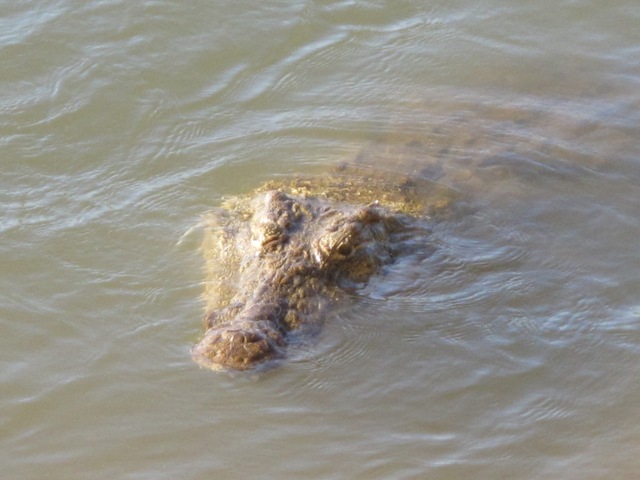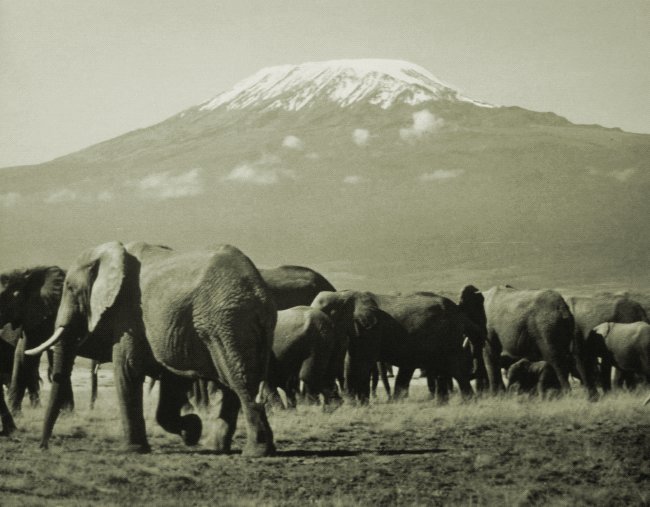 |
 |
Chapter 6 · Dinosaur Land
Eastern Cape, Lesotho & Natal Fossil Sites
Terrible Lizard
Sir Richard Owen created the word dinosaur in 1841. The word was derived from Greek and means terrible lizard. True dinosaurs are those that have a hip joint enabling them to walk upright. In most peoples minds though, the word dinosaur is associated with large extinct lizardlike reptiles that included creatures that walked on four legs. So do they still exist? Yes depending on what your definition of a dinosaur is. If your definition is a ‘large extinct reptile-looking creature that was meant to have lived millions of years ago’ - then they are still around.
| The quickest way to find a ‘dinosaur’ is to go swimming in the Zambezi River, where you would probably meet a large crocodile. Why have the crocodiles and alligators survived, while some of the other ‘dinosaurs’ died out? The reason for this is that water-loving crocodiles would have survived the flood quite easily, while their land counterparts would have been obliterated. The Komodo dragon is a large reptile that lives on the Indonesian Island of Komodo. When these lizards were first found they were rightly described as dinosaurs - having a length of 7 feet and being dangerous to man and beast. Smaller reptiles such as the Iguanas of South America and the Galapagos Islands could also be fitted into the dinosaur category. Reptiles grow until they die and as the conditions were better before the flood, the size of some of the dinosaurs and reptiles would have been larger. |

It's lunchtime; come closer, please ... |
Karroo Fossils
The Karroo rocks and rocks of similar nature in Southern Africa are often divided into a series to support evolution. The problem for evolutionists is that the rocks blend into each other showing one catastrophe, rather than the rocks being deposited over millions of years. Fossils of supposedly different ages are found in similar rocks showing there were no different time periods like the Jurassic etc. In the Cape Province there is no stratigraphical break anywhere within the mass of sediments, which reach thousands of feet in thickness in some places. This includes no break between these and the Karroo rocks. The evidence shows that there was a violent deposition in a short period of time. Mudstones, sandstone, shale etc. were deposited showing a formation by water. Many creatures called mammal-like reptiles and dinosaurs have been dug up in the Karroo, Eastern Cape and Lesotho areas.
Most of the reptilian remains are found in the area lying between Prince Albert and Beaufort West and from around Graaff Reinet. The fossils are often crushed and distorted, while some were rapidly buried in sediment when they died. The Pareiasaurians are heavy built reptiles with a length reaching 9 feet. Quite a number of complete skeletons have been found upside down and with the limbs still articulated. This suggests that the animals had died where they were found by being rapidly covered in silt. These creatures show that they died no ordinary deaths and were buried rapidly by floodwaters. There has been some confusion with many of the fossils dug up in this region, as almost every fossil dug up was given a different scientific name.
With more
complete fossils it has now been found that there are fewer dinosaurs
than originally thought. Many specimens had been built up on
incomplete fossil material. Arthur Cruikshank one of the best
Palaeontologists working in the sub region in recent times, had this to
say about the ageing of dinosaurs and fossils: ‘The quoted age of any
particular tetrapod or plant-bearing formation is often based more on
tradition than any secure framework of correlation. The ages of the
Molteno and Elliot formations are by no means fixed.’ In other words
dinosaur and other fossils are not dated with any scientific method, but
are assumed to be so many years old, according to evolutionary beliefs.
You won’t find experts using carbon dating on a dinosaur, as they
wouldn’t accept a young age for the specimen.
Molteno
The Molteno/Elliot deposits are found in Western Natal, around Lesotho, South Free State and the Eastern Cape. The Molteno deposits cover a rough area of 1500km by 750km. There are many similarities between these deposits and those found in the Karroo and parts of Zimbabwe. These deposits are incredibly rich and include 56 genera with 206 plant species, and 117 genera with 335 insect species found so far. There are in this region some 300,000 vegetative specimens included in the flora. Flooding destroyed all of these specimens and the vertebrate fossils found.
Some fossils were deposited in violent
conditions and were damaged, while others were rapidly and safely
encased in sediment - like some of the insects. Of the many plants found
there were horsetails, conifers, seed ferns, ginkgoes, taeniopteris (shrub
to small tree) and Halleyocteris (cycad-like) as some of the more
common plants. Ferns, mosses, liverworts, herbs and cycads are some of
the less common plants found. The flora shows riverine forest and
floodplain wetlands, thickets, woodlands and Lake Margins. The small
freshwater crustaceans found may have lived in lakes and rivers. The
plants possibly grew in mountainous areas, with cold wet winters. The
insect orders include many found today and some now extinct. The
cockroaches were abundant indicating a closed-canopy terrestrial
habitat where they could live on the leaf litter.
Molteno Dinosaurs
Associated with this unique ecosystem are many vertebrates that are now extinct. An unusual carnivorous amphibian called a Capitosaur was present. This 4 metre long creature probably fed on fish found in rivers or lakes. The fragmentary nature of the Capitosaur fossils showed they died in a high-energy flow system. A large tortoise roamed the forests and woodlands and fed on plants. This animal had a shell that was greater than half a metre in diameter. A large 3 metre long Komodo dragon like creature called a Thecodont hunted in the area. The theropod was a small bipedal dinosaur, which would have fed on small creatures like insects. The Sauropods were large dinosaurs that appeared to be common and could reach a length of 10 metres. These giants may have browsed at a 7-metre height. Some remains of these large dinosaurs were fragmentary, while others were fully articulated. The latter were entombed rapidly in sand or mud by the floodwaters. The former had their bones destroyed by the great forces of rock and water.
The 2-3 metre long dicynodont was fairly
common in Southern Africa. It was a creature that looked like a large fat
pig, with a strange dentition allowing it to pulp vegetation.
Diademodon was a small bear like creature, which may have been an
omnivore. Small crocodilians lived in the lakes or streams. The
Ornithischia dinosaur reached a length of 1.5 metres and ate vegetable
matter. Small creatures similar to elephant shrews and giant rodenttypes,
were some of the smaller creatures found here. Nocturnal
mammalian tree shrews were also found to have lived in the ecosystem.
Tracks
This region has many dinosaur and other tracks. These and those
dinosaur tracks in Zimbabwe and Namibia, human tracks in the Cape
and possibly in Angola may have been made during the flood. The
Waterberg rocks have produced shale containing raindrop impressions,
which could have been made by the rain in the flood. Tidal activity,
mudslides etc. would have covered the tracks of the fleeing animals and
preserved the spoor. A dinosaur track-way in the Zambezi Valley
showed a large dinosaur was moving in an unstable manner and
possibly walking in shallow water leaving its tracks behind. It may have
been desperately trying to find higher ground.
Natal
Natal has not produced as many terrestrial fossils as the Cape, but it has
produced an amazing amount of marine fossils and has abundant coal.
There are a few mammal and dinosaur remains. Port Durnford along
the coast has produced animal and other deposits. It seems that
marshland; grassland, syzgium, myrica, ficus, Podocarpus elements and
some Fynbos were present in Natal before the flood. Some podocarpus
still survive in Natal. The Fynbos present included ericaceae and
anthospermum. An elephant tusk was found in sand south of Durban.
Studies indicate that this elephant, which may have died in the flood,
ate a lot of grass. Near the Durban Country Club a human skull was
found at a depth of 20 feet in sand dunes. The skull was incomplete,
considerably distorted and partially mineralised. The sex was uncertain
and was possibly a juvenile. The nature of the deposit makes it likely
this person died in the flood.
Bivalve
A bivalve Panopea glycymeris is a clam that is remarkable for the size of
its shell - usually about 20 centimetres long, sometimes reaching 30 cm
in length. Fossils have been found in raised beaches at Velddrif, Mossel
Bay and Port Elizabeth. It lives today along the Mediterranean and West
African coasts where the water temperature is usually above 200C, but it
no longer occurs in southern Africa. Its presence in the raised beaches is
evidence for warmer waters around the southern Cape.
Cradock
At Cradock 25 feet below the ground, in course grey, green sand, which
was on some shale, a pig was found, a possible (kudu/bushbuck),
possible large reedbuck, (zebra/horse), giant buffalo, giant hartebeest,
wildebeest, gemsbok, gazelle and steenbok. The type of animals found
here show that there was more open country in the vicinity. It is
interesting that in Aliwal North a Thecodont and Tuatara were found in
greenish grey sandstone, which was highly calcareous. Both fossil sites
mentioned above were deposited in very similar rocks and using
evolutionary theory, this would imply that the mammals and dinosaur
relatives were deposited in the same time period.
Eastern Cape
Dr. P.W.Lardler found a human thighbone at the base of a consolidated
boulder bed in 1933. The locality was the Blind River site close to East
London. This boulder bed was about 8 feet thick and covered by about
25 feet of other deposits. The person was thought to be a female with an
estimated height of 160.6cm. This person may have died in the flood. A
fossil of a plesiosaur has been retrieved near Port Elizabeth, where it
was dug out of the cliffs of the Zwartkops River.
What It Was Like
In summary there was probably a specialised habitat of very wet forests and woodlands with ferns, conifers and swamps in areas around Lesotho. It was an ideal habitat for plant eating dinosaurs because of the amount and type of vegetation. The altitude and specialised conditions may be the reason why few mammals have been found here. The Natal side of the Molteno would have been less wooded. As we go into the Northern Cape and Free State there would have been less of this vegetation and the country more suitable for Wildebeest etc. and animals we are more familiar with.

Mt. Kilimanjaro, Africa

| << PREV |
|